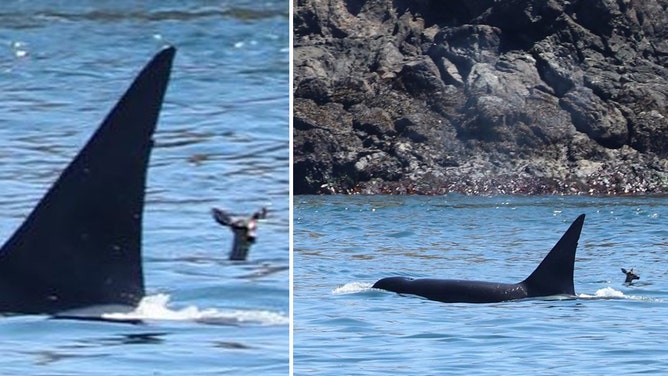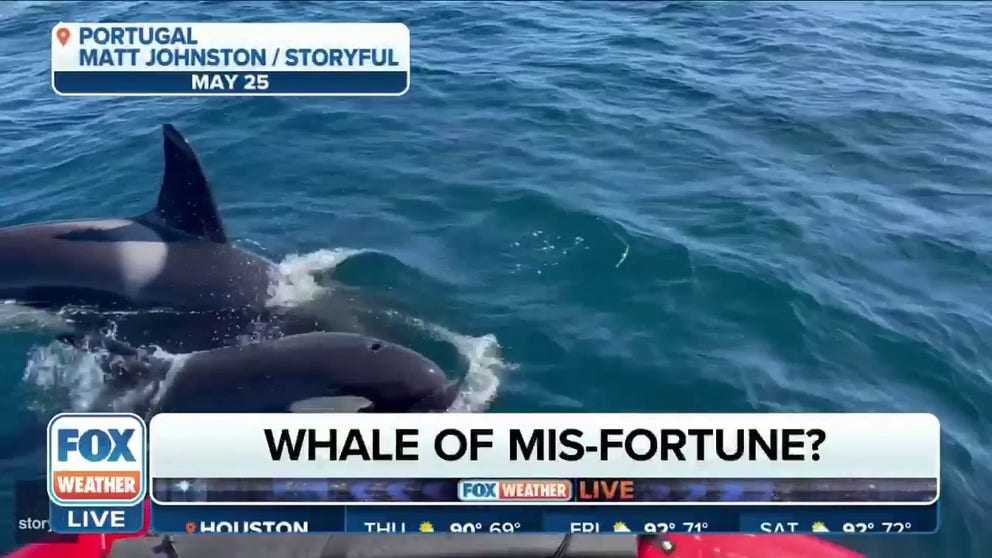See it: Deer finds most unusual mammal-eating friend to swim with off Washington coast
Fortunately for this deer, this killer whale wasn't planning to have the venison on the menu.
Utah city comes up with innovate way to help deer cross roads
Wildlife biologist and environmental planner Todd Black discusses placing deer decoys so real deer can cross busy roadways comfortably and avoid vehicles.
BATTLESHIP ISLAND, Wash. – Two words: "Oh, deer!"
That's how Pacific Whale Watch Association (PWWA) described what the wildlife tour guests aboard Island Adventures Whale Watching witnessed Sunday along Battleship Island, a small island northwest of San Juan Island in Washington. A deer was seen taking a swim with a mammal-eating killer whale.
'HANG ON, BUDDY!' SWIMMING DEER RECEIVES WORDS OF ENCOURAGEMENT FROM FISHERMAN

Island Adventures Whale Watching said wildlife tour guests witnessed a deer swimming with a mammal-eating killer whale on Sunday at Battleship Island, Washington.
(Sam Murphy / Island Adventures Whale Watching)
It was a beautiful day for watching Bigg’s killer whales, the whale-watching tour said in their daily report, noting they were lucky enough to spend time with two different groups of killer whales.
While at Battleship Island, they met up with T124C, a lone male known as Cooper who was taking laps with an unlikely partner.
"We didn’t realize it at the time, but our photos revealed he swam right past a black-tailed deer," the company said. "What are the odds of that?"
Fortunately for this deer, this killer whale wasn't planning to have the venison on the menu.
Sam said that the whale swam right by and didn't seem interested in the deer at all. In fact, Sam didn't notice the deer until she was looking at her pictures afterward, making for a fun surprise.
Erin Gless, executive director of the PWWA, told FOX Weather that there is probably not enough meat and fat on a deer's bones to tempt these whales, as they usually feed on seals and sea lions in this region.
"Would probably be intimidating for the deer, though, I'm sure," Gless said.
PEOPLE ARE PANICKING OVER ‘ZOMBIE DEER’ — HERE ARE THE FACTS

Fortunately for this deer, this killer whale wasn't planning to have the venison on the menu.
(Sam Murphy / Island Adventures Whale Watching)
According to wildlife officials, deer are strong swimmers, reaching speeds of around 15 mph in the water, according to World Deer. Their strong leg muscles, as well as their hooves and toes, provide great agility in the water.
There are nearly 400 Bigg’s killer whales that feed in the waters of Washington and British Columbia, according to the PWWA. They can be seen almost daily in the Salish Sea and are increasing in numbers due to the abundance of seals and sea lions in the area.
Last year, the PWWA said they saw record-breaking numbers of Bigg’s killer whales and humpback whales spotted in the waters of British Columbia and Washington state. There have also been continued signs of progress within the Salish Sea ecosystem.
WATCH: GREAT WHITE SHARK FEEDS ON DEAD WHALE AS IT DRIFTS TOWARD NEW YORK
Why are killer whales attacking ships?
Marine Mammal Biologist Hanne Strager discussed recent orca attacks on ships off the Iberian Peninsula with FOX Weather. Scientists can't agree on why it is happening but Strager gives a few theories.
"When Bigg's were first studied in the Salish Sea, it was just after the implementation of the Marine Mammal Protection Act," said Monika Wieland Shields, director of Orca Behavior Institute. "In the decades since, seals, sea lions and porpoises have all recovered in spectacular fashion. The Salish Sea can now support many more killer whales than it used to, and clearly, word has spread."
Last year, more than 35,000 sightings of whales and other wildlife were reported to PWWA by professional whale watchers and authorized contributors.
Humpback whales and Bigg’s killer whales were the two whale types most frequently documented, with humpbacks reported on 310 days and Bigg’s killer whales reported on 293 days.

